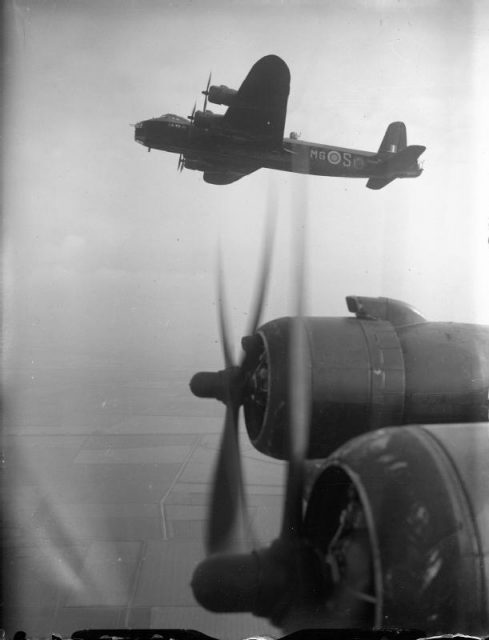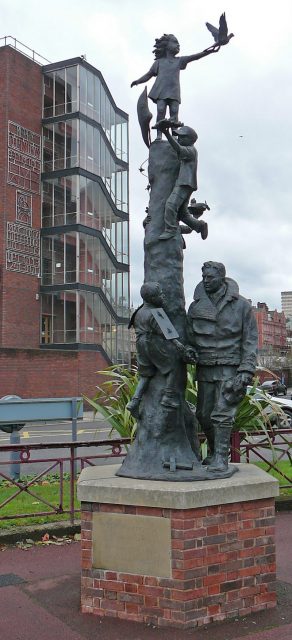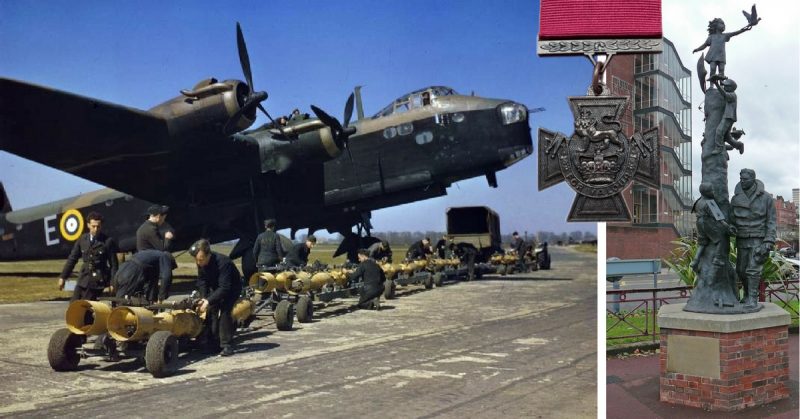Every time an Allied bomber set out for the skies over Europe the crew began to play a dangerous game of odds as to whether they would return. Awaiting the bombers were squadrons of enemy fighters, hordes of anti-aircraft guns and the long cold distance between the objective and home. It was not uncommon for a crew and their aircraft to return shot to pieces. However, when a vital piece of equipment or, in this case, the pilot did not make it – neither did the entire crew.
Flight Sergeant Arthur Aaron was piloting his Stirling Bomber over Italy when it was struck by several devastating bursts from enemy fire. Three engines were hit, several turrets were out of action and worse, pilot Aaron had been shot in the face, tearing away part of his jaw. Despite his severe pain and loss of blood, Aaron continued to perform his duty and save the remainder of his crew.
Aaron piloted the aircraft himself until he could no longer sit. Then, due to being unable to speak, he wrote down instructions for his bomb-aimer and guided his crew home to North Africa and safety. In doing so, Aaron was awarded the Victoria Cross and the eternal gratitude of a crew watching him give his last breath for their sake.
An Early Career
Arthur Aaron was born in 1922 in Leeds, Britain, to a typical family of the area. Little did the region know that this young man, who seemed nothing extraordinary, would go on to earn a hallowed place in military history. After receiving his education at Roundhay School and Leeds School of Architecture, Aaron did as many men his age did when his nation entered the greatest conflict the world has ever known. In 1939, he joined the Air Training Corps and subsequently trained as aircrew with the Royal Air Force.
He had always had a desire to fly and, with his nation at war, he headed to the United States of America to train as a pilot at the No. 1 British Flying Training School in Terrell, Texas. Wrapping up his training in late 1941, Aaron headed back home ready to make his contribution to the war effort.
For Aaron, the war put him in the pilot’s seat of a Short Stirling heavy bomber. The four-engined aircraft saw its fair share of work during the war and Aaron took one particular sortie into military history with him. Prior to the action in which Aaron received his Victoria Cross, he had picked up the Distinguished Flying Medal for receiving heavy fire and yet managing to bring his badly damaged bomber back home. Perhaps it foreshadowed his future action, but it remained clear that as a pilot Aaron was determined to make the return trip at all costs.

One Final Flight
As distinguished as Aaron’s career was, it was a flight in late 1943 at the age of 21 that earned him a hallowed and unique place in military history. On the evening of August 12, 1943, Aaron took to the skies with his crew in his Stirling bomber headed for Turin, Italy.
As they approached their target they were met by enemy aircraft attempting to deny them access. With enemy fighters soaring through the sky, Aaron’s Stirling took a ferocious burst of fire from an enemy pilot with a sure aim. The result was three engines damaged, the front and rear turrets disabled, the windscreen shattered to pieces and the elevator controls damaged. Even a very experienced pilot would be challenged to continue to fly the plane, but the situation was about to get worse.
Several crew members were wounded, the navigator had been killed and pilot Aaron had received a bullet wound straight to the face. His jaw was broken, part of his face had been torn away and as he began to lose blood he slumped over the controls. The aircraft quickly lost altitude. The flight engineer roused Aaron and the injured pilot motioned to the bomb-aimer to take over the controls. With no hope of accomplishing their mission Aaron, using hand gestures and written notes, ordered the crew to head south for either Allied controlled Sicily or North Africa.
At that point, while in extreme pain, Aaron was taken to the back of the plane and given a dose of morphine to help ease his pain. Had he remained there and nursed his wounds he may very well have survived. However, had he done so, his crew may never have made it to save territory.
Understanding his duty, Aaron returned to the cockpit to do his best for his men. He attempted to take over the controls several times, but his weak state would not allow it. Despite his pain and fatigue and being unable to speak, Aaron continued to support his crew by writing down directions.

A Hard Landing
The next five hours seemed to take an eternity for the crew as they piloted their way across the Mediterranean in the pitch black. However, thanks to the continued support of the only pilot on the plane, the beautiful sight of a friendly airfield emerged on the horizon. Bone Airfield in Algeria was a former German facility which had been captured by the Allies.
Unfortunately for the crew, it was the most dangerous part of the journey. Landing the damaged aircraft in the dark was no small feat, but Aaron was there to guide the way. After four failed attempts to land using the bomb-aimer, Aaron was on the verge of collapse. On the fifth attempt the beat up Stirling made its way to the ground.
Pilot Aaron had – without being able to utter a single word – guided his crew home. Aaron survived the landing, but nine hours afterwards he succumbed to his wounds. It was noted in his Victoria Cross citation that had Aaron remained at rest and treated his wounds he might have survived the encounter. However, doing so would have risked his crew and Aaron instead chose to do his duty.
At just 21 years of age, this young pilot cemented his place in British military history and demonstrated inexplicable gallantry in keeping with the highest traditions of the Royal Air Force.
